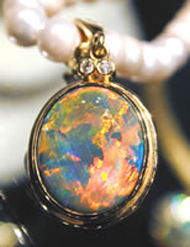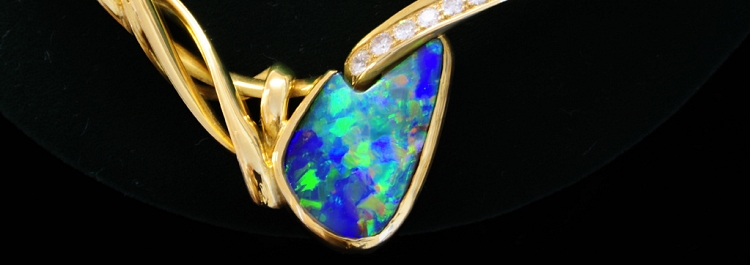 Australian opal is found in sedimentary rocks aged 115-100 million years. Most opal is very hard and will scratch glass. The opal has survived extremes of temperature, pressure and chemical reactions for many millions of years. Then, of course, it has also withstood the rigours of the mining process. There are a few areas at some fields which may on occasions produce unstable material. This material is likely to have been mined at a deep level resulting in the opal having a higher than normal water content. As the opal dries and releases some of the excess water in its structure it can shrink which can lead to cracking. Whilst these problems are very rarely encountered, it is recommended that you buy your opal from reputable traders who know and understand the origins of the stone and guarantee the stones they sell.
Australian opal is found in sedimentary rocks aged 115-100 million years. Most opal is very hard and will scratch glass. The opal has survived extremes of temperature, pressure and chemical reactions for many millions of years. Then, of course, it has also withstood the rigours of the mining process. There are a few areas at some fields which may on occasions produce unstable material. This material is likely to have been mined at a deep level resulting in the opal having a higher than normal water content. As the opal dries and releases some of the excess water in its structure it can shrink which can lead to cracking. Whilst these problems are very rarely encountered, it is recommended that you buy your opal from reputable traders who know and understand the origins of the stone and guarantee the stones they sell.
Solid opal
Australian opal has a typical hardness of 6 to 7 on Mohs scale of hardness from 1 to 10. (Pearl = 3.5, glass = 5, tanzanite = 6.5, emerald = 7.75, sapphire = 9, diamond = 10). Opal is quite resistant but (as is the case with any valuable jewellery) care should be taken to avoid situations where the opal could come in contact with abrasives or be subject to impact. Thick stones are more resilient than thin stones. If you intend to store an opal for a long period in a safe or safety deposit, it is recommended the item be placed in a sealed container or plastic bag with a small amount of water on a dampened cloth. Safes are a de-humidified environment and are unnaturally drying. Follow these simple rules and your opal will give you a lifetime of pleasure and become a treasured heirloom.
Triplets, doublets and inlay
It is very important to protect doublet and inlay opals from impact. On some occasions, the opal is just a thin veneer, which is likely to crack if dropped on a hard surface. As triplets, doublets and inlay are laminates, the glue used to make the composite could deteriorate if submerged in liquids and particularly detergents. Water and detergents does not affect solid opals.





